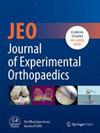Comparative effects of hip capsule repair and cam lesion excision on capsulotomy healing: An in vivo biomechanical and histological analysis
Abstract
Purpose
This study evaluates the effects of hip capsule repair and cam lesion excision on capsular healing by assessing biomechanical strength and histological integrity in an in vivo rabbit model.
Methods
An in vivo rabbit model with 80 rabbits was used, where capsulotomy was performed on the right hip of each subject. The rabbits were assigned into four groups: Group 1 (capsulotomy without repair), Group 2 (capsulotomy with capsule repair), Group 3 (capsulotomy + cam resection without repair), Group 4 (capsulotomy + cam resection + capsule repair). Each group was stratified into 4-week and 8-week follow-up subgroups. Biomechanical testing assessed maximum tensile strength, while histological evaluation included semiquantitative grading of collagen arrangement, inflammatory response, osteogenesis, and angiogenesis.
Results
Histological analysis revealed superior healing in the capsule repair + cam resection group (Group 4) compared to the unrepaired capsulotomy group (Group 1) (p = 0.01). Biomechanical testing demonstrated that capsule repair (Group 2) improved strength over unrepaired capsulotomy (135.2 N vs. 111.9 N, p = 0.03). Cam resection alone (Group 3) resulted in significantly higher strength than unrepaired capsulotomy (163.2 N vs. 111.9 N, p = 0.01). The combination of cam resection and capsule repair (Group 4) demonstrated superior strength, outperforming capsule repair alone (176 N vs. 135.2 N, p = 0.01). At 8 weeks, the capsule repair + cam resection group (Group 4a) showed significantly enhanced biomechanical strength compared to the unrepaired capsulotomy group (Group 1a) (181.6 N vs. 120.9 N, p = 0.001) and capsule repair alone (Group 2a) (181.6 N vs. 125.8 N, p = 0.01).
Conclusion
Our findings indicate that cam resection, particularly when combined with capsule repair, significantly improves biomechanical strength and enhances the healing process of the capsule. These findings offer practical guidance for optimising surgical strategies to enhance patient outcomes and long-term joint function.
Level of Evidence
Level III, experimental therapeutic study (prospective and controlled).

 求助内容:
求助内容: 应助结果提醒方式:
应助结果提醒方式:


